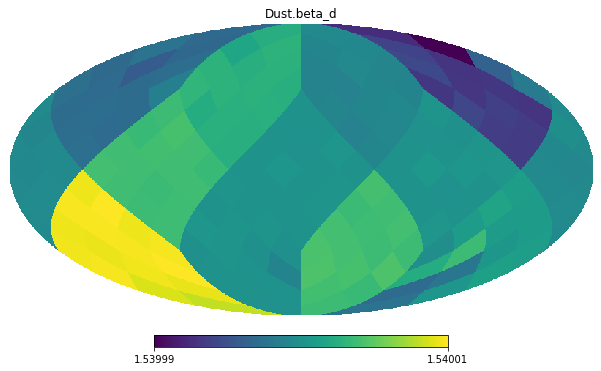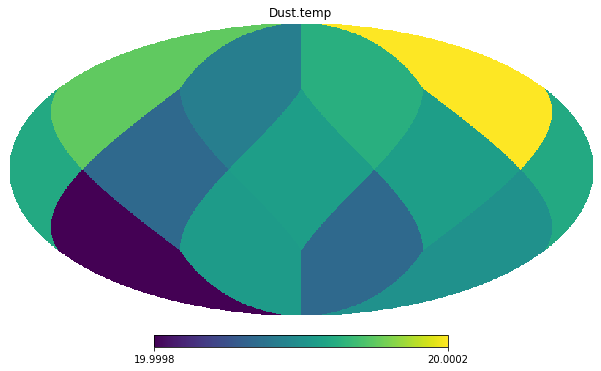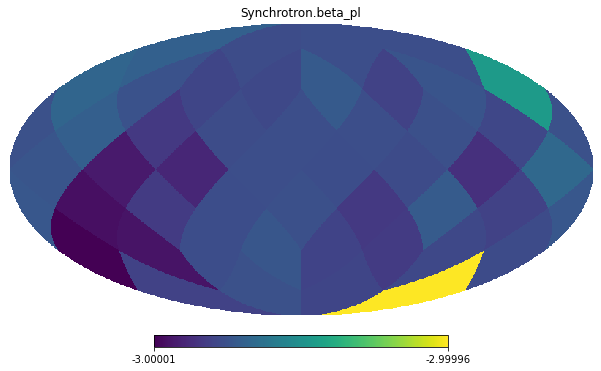Multi-resolution separation¶
[1]:
%load_ext autoreload
%autoreload 2
%matplotlib inline
import numpy as np
import pylab
pylab.rcParams['figure.figsize'] = 12, 16
import healpy as hp
import pysm3
import pysm3.units as u
from fgbuster import get_instrument, get_sky, get_observation # Predefined instrumental and sky-creation configurations
import fgbuster.separation_recipes as sr
# Imports needed for component separation
from fgbuster import (CMB, Dust, Synchrotron, # sky-fitting model
MixingMatrix) # separation routine
From more basic examples you know that basic_comp_sep allows you to tile the sky in healpix pixels at a given nside and perform the fit of the spectral parameters independently for each tile. However, you potentially want to fit different parameters at different resolutions. You can achieve this with the multi_res_comp_sep utility function in separation_recipes. Here is an example of how it works.
Simulate your frequency maps¶
[2]:
nside = 8
sky = get_sky(nside, 'c1d0s0')
instrument = get_instrument('LiteBIRD')
freq_maps = get_observation(instrument, sky)
freq_maps = freq_maps[:, 1:] # Select polarization
/Users/dpoletti/opt/miniconda3/envs/cosmo/lib/python3.7/site-packages/pysm3/utils/data.py:42: UserWarning: Retrieve data for pysm_2/camb_lenspotentialCls.dat (if not cached already)
warnings.warn(f"Retrieve data for {filename} (if not cached already)")
/Users/dpoletti/opt/miniconda3/envs/cosmo/lib/python3.7/site-packages/pysm3/utils/data.py:42: UserWarning: Retrieve data for pysm_2/delens_ells.txt (if not cached already)
warnings.warn(f"Retrieve data for {filename} (if not cached already)")
/Users/dpoletti/opt/miniconda3/envs/cosmo/lib/python3.7/site-packages/pysm3/utils/data.py:42: UserWarning: Retrieve data for pysm_2/dust_t_new.fits (if not cached already)
warnings.warn(f"Retrieve data for {filename} (if not cached already)")
/Users/dpoletti/opt/miniconda3/envs/cosmo/lib/python3.7/site-packages/pysm3/utils/data.py:42: UserWarning: Retrieve data for pysm_2/dust_q_new.fits (if not cached already)
warnings.warn(f"Retrieve data for {filename} (if not cached already)")
/Users/dpoletti/opt/miniconda3/envs/cosmo/lib/python3.7/site-packages/pysm3/utils/data.py:42: UserWarning: Retrieve data for pysm_2/dust_u_new.fits (if not cached already)
warnings.warn(f"Retrieve data for {filename} (if not cached already)")
/Users/dpoletti/opt/miniconda3/envs/cosmo/lib/python3.7/site-packages/pysm3/utils/data.py:42: UserWarning: Retrieve data for pysm_2/synch_t_new.fits (if not cached already)
warnings.warn(f"Retrieve data for {filename} (if not cached already)")
/Users/dpoletti/opt/miniconda3/envs/cosmo/lib/python3.7/site-packages/pysm3/utils/data.py:42: UserWarning: Retrieve data for pysm_2/synch_q_new.fits (if not cached already)
warnings.warn(f"Retrieve data for {filename} (if not cached already)")
/Users/dpoletti/opt/miniconda3/envs/cosmo/lib/python3.7/site-packages/pysm3/utils/data.py:42: UserWarning: Retrieve data for pysm_2/synch_u_new.fits (if not cached already)
warnings.warn(f"Retrieve data for {filename} (if not cached already)")
Define what you fit for¶
Create your sky model as a list of components
[3]:
components = [CMB(), Dust(353.), Synchrotron(23., running=None, nu_pivot=70.)]
[4]:
for comp in components:
comp.defaults = [d*1.05 for d in comp.defaults]
Component separation¶
multi_res_comp_sep has almost the same signature of basic_comp_sep. The only difference is the nside parameter, which becomes nsides. It is no longer an integer but a list of integers, each specifying the resolution of a parameters.
[5]:
nsides = [4, 1, 2, 0]
Which means that
[6]:
for nside, param in zip(nsides, MixingMatrix(*components).params):
print(f"{param} is fitted for at nside {nside}")
Dust.beta_d is fitted for at nside 4
Dust.temp is fitted for at nside 1
Synchrotron.beta_pl is fitted for at nside 2
Synchrotron.running is fitted for at nside 0
[7]:
result = sr.multi_res_comp_sep(components, instrument, freq_maps, nsides=nsides)#, method='L-BFGS-B', options=dict(disp=True)) ))
Note that all the parameters are fitted simultaneously. This makes the maximization of the likelihood substantially more difficult. Consider tuning the parameters of the minimizer `scipy.optimize.minimize <https://docs.scipy.org/doc/scipy/reference/generated/scipy.optimize.minimize.html>`__
Explore the results¶
Unlike basic_comp_sep, res.x is now a list — since the maps have different resolutions you can not stack them in an ndarray — but you access the maps of each parameters in the same way.
[8]:
for par_x, par in zip(result.x, result.params):
if len(par_x)>1:
hp.mollview(par_x, title=par)
else:
print(par, par_x[0])
Synchrotron.running -3.1962021434923297e-06



The amplitudes of the components are stacked in the s attribute and they are in the same format of the input frequency maps: Q and U healpix maps, in this case.
[9]:
hp.mollview(result.s[0,0], title='CMB Q out', sub=(1, 3, 1))
hp.mollview(sky.components[0].map[1].value, title='CMB Q in', sub=(1, 3, 2))
hp.mollview(result.s[0,0] - sky.components[0].map[1].value, title='CMB Q diff', sub=(1, 3, 3))

[10]:
ref = sky.components[1].Q_ref.to(u.uK_CMB, equivalencies=u.cmb_equivalencies(sky.components[1].freq_ref_P)).value
hp.mollview(result.s[1, 0], title='Dust Q out', sub=(1, 3, 1))
hp.mollview(ref, title='Dust Q in', sub=(1, 3, 2))
hp.mollview(result.s[1, 0] - ref, title='Dust Q diff', sub=(1, 3, 3))

[11]:
ref = sky.components[2].Q_ref.to(u.uK_CMB, equivalencies=u.cmb_equivalencies(sky.components[2].freq_ref_P)).value
hp.mollview(result.s[2, 0], title='Dust Q out', sub=(1, 3, 1))
hp.mollview(ref, title='Dust Q in', sub=(1, 3, 2))
hp.mollview(result.s[2, 0] - ref, title='Dust Q diff', sub=(1, 3, 3))
